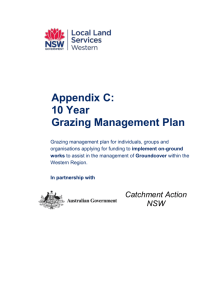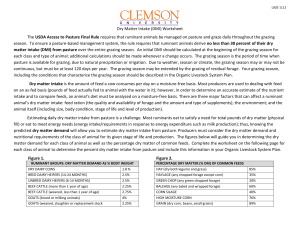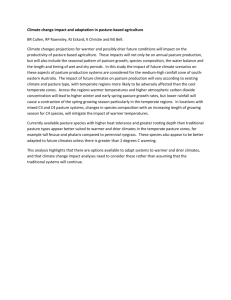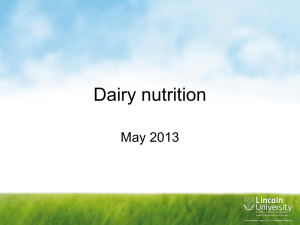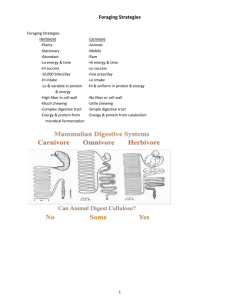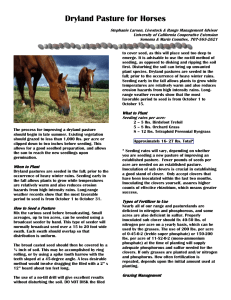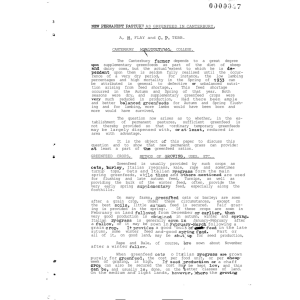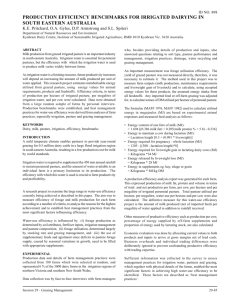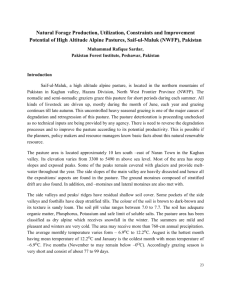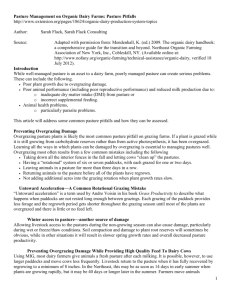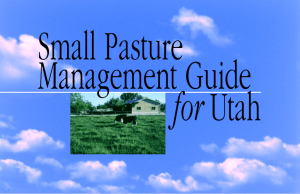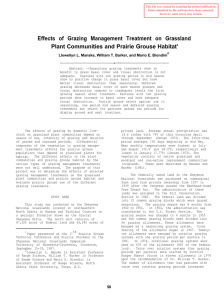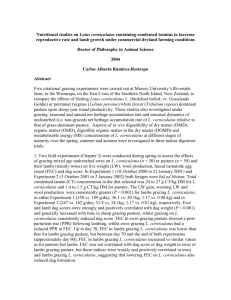Pasture, Foraging and Shelter Design
advertisement
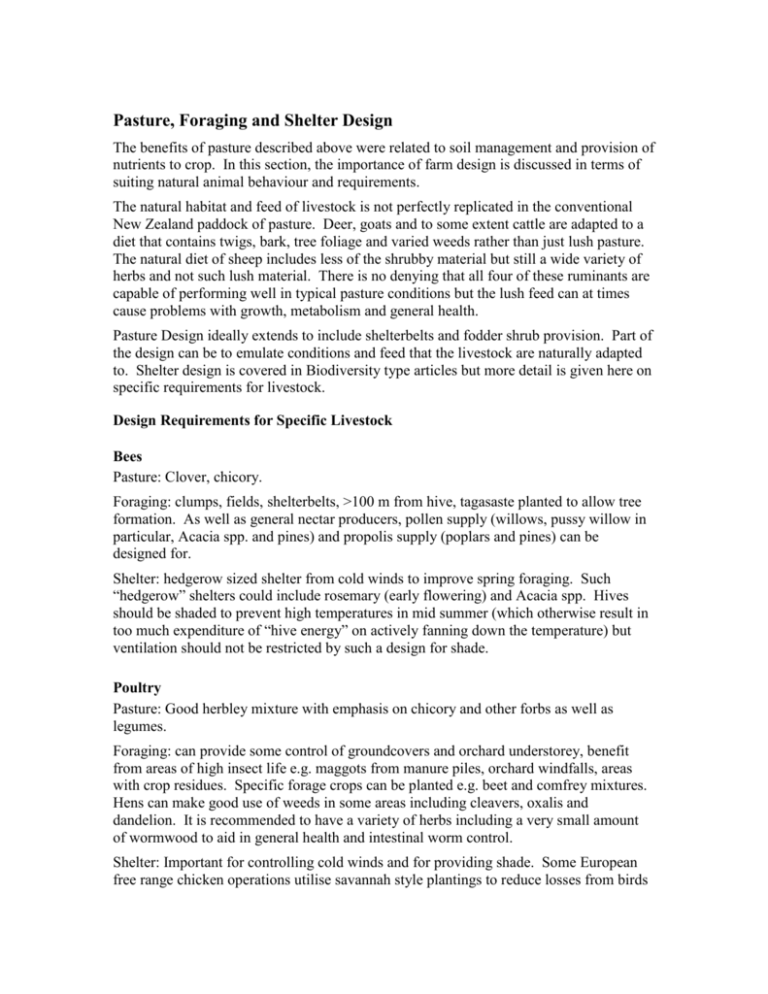
Pasture, Foraging and Shelter Design The benefits of pasture described above were related to soil management and provision of nutrients to crop. In this section, the importance of farm design is discussed in terms of suiting natural animal behaviour and requirements. The natural habitat and feed of livestock is not perfectly replicated in the conventional New Zealand paddock of pasture. Deer, goats and to some extent cattle are adapted to a diet that contains twigs, bark, tree foliage and varied weeds rather than just lush pasture. The natural diet of sheep includes less of the shrubby material but still a wide variety of herbs and not such lush material. There is no denying that all four of these ruminants are capable of performing well in typical pasture conditions but the lush feed can at times cause problems with growth, metabolism and general health. Pasture Design ideally extends to include shelterbelts and fodder shrub provision. Part of the design can be to emulate conditions and feed that the livestock are naturally adapted to. Shelter design is covered in Biodiversity type articles but more detail is given here on specific requirements for livestock. Design Requirements for Specific Livestock Bees Pasture: Clover, chicory. Foraging: clumps, fields, shelterbelts, >100 m from hive, tagasaste planted to allow tree formation. As well as general nectar producers, pollen supply (willows, pussy willow in particular, Acacia spp. and pines) and propolis supply (poplars and pines) can be designed for. Shelter: hedgerow sized shelter from cold winds to improve spring foraging. Such “hedgerow” shelters could include rosemary (early flowering) and Acacia spp. Hives should be shaded to prevent high temperatures in mid summer (which otherwise result in too much expenditure of “hive energy” on actively fanning down the temperature) but ventilation should not be restricted by such a design for shade. Poultry Pasture: Good herbley mixture with emphasis on chicory and other forbs as well as legumes. Foraging: can provide some control of groundcovers and orchard understorey, benefit from areas of high insect life e.g. maggots from manure piles, orchard windfalls, areas with crop residues. Specific forage crops can be planted e.g. beet and comfrey mixtures. Hens can make good use of weeds in some areas including cleavers, oxalis and dandelion. It is recommended to have a variety of herbs including a very small amount of wormwood to aid in general health and intestinal worm control. Shelter: Important for controlling cold winds and for providing shade. Some European free range chicken operations utilise savannah style plantings to reduce losses from birds of prey. In New Zealand hawks have been observed to ignore such plantings and simply walk along the ground to prey in young hens. Birds of prey will require other forms of control such as roosters, dogs, physical barriers or more active intervention. Good trees and associated plants to include in foraging systems include Acacia (most species have edible seed for hens), boxthorn (Lycium spp.), mulberry, pigeon pea, Solanum (the berry producing species), tagasaste, and a variety of fruit trees. Pigs Pasture: Good mixture of species, not too much rank or dry grass. Plenty of legumes (including lucerne) and chicory. Foraging: Root crops including potatoes, Jerusalem artichoke. Comfrey, broadbeans (Vicia faba). Shelter: Sheltered and shaded areas are desired. Some suitable trees to benefit a foraging system include apple, fig, oaks, olive, pear, plums and sweet chestnut. Sheep, Goats, Cattle, Deer Pasture: Good mixture of species, good clover levels, chicory, plantain, yarrow, sheeps burnet and parsley. Foraging: forage shrubs such as tagasaste. Shelter: Good shelter and some provision of shade, extra attention for lambing areas. Forage trees include tagasaste, fodder poplar and willow species. Pampas grass (where it is not a noxious weed issue). Grazing Management There are several points of difference between good grazing management on a mixed herbley, no drench system as compared to conventional pasture. Grazing to provide intestinal roundworm control is discussed in the later section on Animal Health Management – the essential aim there is to present clean pasture at times of high risk. A major aim for organic grazing management is to maintain the diversity of species in the pasture mixture. This is best achieved by light grazing followed by a resting period sufficient to let every species recover. Some species in the herbley (e.g. sheeps burnet, parsley) are difficult to keep in the rotation and may be difficult to establish in a mixed pasture in the first place; such plants could be grown in less competitive mixes perhaps at headlands or in strips which can have light grazing. Attention still needs to be paid to avoiding too much rank growth (this could be achieved in part by cattle grazing or by topping if required). Light grazing avoids some of the problems of grazing too short such as… picking up DDT isomer residues picking up internal parasites soil contamination causing excess iron levels reducing copper utilisation But the lack of soil contamination could conceivably reduce cobalt intake leading to a cobalt/Vitamin B12 requirement. Any such problem is ideally offset by the presence of forbs and good gut efficiency. Feed budgeting should be practiced so that grazing decisions are made in advance. Observation is then made on feed quantity and quality and the rotation is adjusted as required. There may be exceptions to the planned rotation system. One practice used is to lightly set stock avoiding perceived problems with constant shifting cattle and associated heirarchy forming and stress problems. Good husbandry includes observations on pasture quantity and quality and requirements for shifting stock. A feed budget


